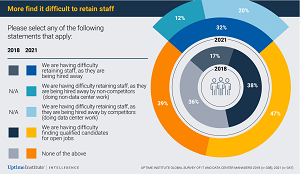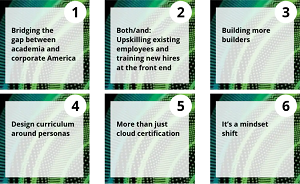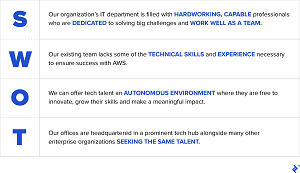News
How to Address Crippling Cloud Skills Shortage?
Over the past several years, we at Virtualization & Cloud Review have noticed a common theme among survey-based reports on cloud computing: the difficulty in finding skilled, talented staffers is holding back enterprise cloud initiatives across the board.
For example, here's just a taste:
The COVID-19 pandemic is often cited as a primary driver of the skills shortage, as it forced a huge uptick in cloud computing. Deloitte, which has a consulting organization, summarized the problem: "Acute shortages in cloud roles include developers, engineers, architects, and strategists. At the same time, COVID-19 has accelerated the need for cloud-based, secure remote-work platforms and solutions to automate technology. Consider the numbers: Cloud job postings soared 94 percent between 2017 and 20201, and have accelerated during the pandemic, exacerbated by challenges in various global talent markets and the Great Resignation."
The Uptime Institute summarized the multiyear problem in a general datacenter context with a graphic from its "2021 Data Center Industry Survey" report:
 [Click on image for larger view.] Getting More Difficult to Retain Staff (source: Uptime Institute).
[Click on image for larger view.] Getting More Difficult to Retain Staff (source: Uptime Institute).
As the issue shows no signs of slowing down, what's to be done to at least mitigate it?
Deloitte offered advice to address the cloud talent crunch, explained in an article titled "Six ways to tackle the massive software engineering skills shortage" with guidance to "Transform your cloud workforce with modern engineering and a new model for training and upskilling professionals," illustrated in a graphic:
 [Click on image for larger view.] Six Fundamental Ways to Address the Cloud Talent Crunch (source: Deloitte).
[Click on image for larger view.] Six Fundamental Ways to Address the Cloud Talent Crunch (source: Deloitte).
Some of those items aren't self-explanatory, so click on the link to learn about each one.
In another article, "Dealing with the cloud computing skills gap," the firm advises organizations to assess existing skills among staff and then define where they need to be, after which they can address the gap with strategies including:
- Training: Leverage inside or outside training to help provide the required cloud computing skills to existing staffers.
- Hiring: Find net new employees that bring the required cloud computing skills. This could also mean hiring outside consulting or other contract employees.
- Replacing: Consider replacing existing staffers with staff that have the required skills. This may also mean reducing the number of as-is staffers due to the fact that fewer of them may be required for a post-cloud computing enterprise.
Following are more sources for advice. As with the Deloitte guidance, they won't be discussed in detail here, but rather serve as a bullet-point-oriented resource with links for further investigation.
McKinsey & Company, a management consulting firm, also offers "Six practical actions for building the cloud talent you need," (six seems to be the magic number here) summarized as:
- Find engineering talent with broad experience and skills
- Balance talent maturity levels and team composition
- Build an upskilling program that is extensive, mandatory, and focused on need
- Build an engineering culture that optimizes the developer experience
- Consider using partners to accelerate development, and assign your best cloud leaders as owners
- To keep top talent from leaving, focus on what motivates them
"Without cloud talent, the value that cloud offers is simply unattainable," Mckinsey said in conclusion "Companies can win the war for cloud talent, however, when they combine a clear understanding of what talent they really need, a culture where that talent can thrive, and a commitment to practical changes so they can capture cloud value quickly."
The Linux Foundation's Clyde Seepersad outlined his own thoughts on the matter in an article on The New Stack that emphasized one of the above points, upskilling, as indicated in the title, "You Can't Hire Your Way Out of the Cloud Skills Shortage."
"Organizations need to realize that no matter how high of wages they offer, how many acquihire [see definition below] deals they engage in, or how heavily they recruit, they are not going to be able to fill all their needs for cloud talent. The only way to face this challenge successfully is to take steps to grow the talent pool itself," he said. Here's the requisite bullet-point summary:
- Hire Underqualified Individuals and Train Them
- Advertise Training Opportunities When Recruiting
- Take Advantage of Certification Exams
- Sponsor Scholarship Programs
"There is no panacea for the cloud skills shortage, and the only way the world will ever truly have a sustainable talent pipeline in the technology industry is to bring more individuals from diverse backgrounds all around the world in," Seepersad said in conclusion. "That is a long-term goal that will require everyone from governments to educational institutions to private enterprises working together to introduce technology early and provide the resources to make it possible for everyone to pursue a career in this sector. In the interim, shifting the paradigm of how recruitment happens, changing the expectations of what a qualified candidate looks like, and providing opportunities for ongoing, skills-based training for both technology industry veterans and newbies alike."
In another article, the Linux Foundation explained more about that "acquihire" reference above.
"Traditionally, when there is a tight market for a particular technology skill, we have seen companies that can afford to offer higher wages do so," the article said. " 'Acquihire' activities take place where a company buys out another company for the primary purpose of acquiring the talent it has on staff. Other companies choose to delay projects, or outsource them to consultants. The reality of the situation today though is that any of these solutions are only stopgaps; no one, no matter how big or well funded, can hire their way out of the cloud skills shortage.
"Employers need to evaluate the talent they already have to begin with. Companies that are going through major digital transformation projects are likely going to have teams with significant experience and skills in technologies that will be phased out. They should take this opportunity to train these individuals in the skills they will need to possess to manage the new modern technology stack being implemented. This not only saves having to recruit, but instills loyalty as these individuals see their employer investing in their professional development."
Careers firm Dice couldn't meet the magic number six so instead it offered "5 Ways to Address the Cloud Skills Shortage."
- Hire a Diverse Team
- Invest in Training and Education
- Prioritize Cloud Security
- Hire People Who Can Align Business and Cloud
- Look for Varied Cloud Service Model Experience
"The COVID-19 pandemic has accelerated digital transformation and the movement of applications to the cloud," Dice said. "With these accelerated cloud migrations, cloud skills will be more in-demand than ever. Companies that can address the skills gap and handle cloud migrations at the same time will succeed in the 'cloud wars.'"
As you can see, many experts advise a self-assessment as a first step to address the skills shortage. To determine hiring needs, freelancing specialist Toptal advises organizations to conduct a SWOT analysis in the article "How to Weather the Cloud Skills Shortage."
SWOT stands for Strengths, Weaknesses, Opportunities, Threats, described as "an excellent way to assess your current standing and identify methods for boosting hiring success."
 [Click on image for larger view.] Conduct a SWOT Analysis to Determine Your Hiring Needs (source: Toptal).
[Click on image for larger view.] Conduct a SWOT Analysis to Determine Your Hiring Needs (source: Toptal).
Toptal also advises organizations to identify which positions are best in-house vs. outsourced and to recognize the advantages of agile talent to widen their pool. Agile talent is described as "a special classification of contractors. In most cases, these professionals handle high-level strategic or technical work and may come aboard either full-time or part-time, on a temporary or project-only basis."
Toptal further said: "While it can take several weeks or months to find, hire, and onboard an in-house employee, you can find and engage agile talent in a matter of days. By bypassing arduous and time-consuming recruiting and hiring processes, you can tackle critical tech projects faster and quickly bring your organization up to speed. Plus, once projects are complete, you don't have to worry about finding new ways to get value from your hire. Agile talent can work on a per-project basis -- meaning you only have to bring them in when you need their expertise."
Forbes went all out in its bullet-point article, with 11 such advice nuggets in the article "11 Steps To Unlock Cloud Potential With The Right Skills And Talent":
- Enable leadership for a cloud-first mindset.
- Establish Central Cloud CoE (CCoE).
- Focus on tech intensity and raise technology quotient.
- Establish cloud innovation hackathons with gamification.
- Adopt hyper-automation and a well-architected framework (WAF).
- Leverage on-demand consultant network.
- Partner with hyperscalers.
- Outsource cloud operations.
- Establish co-innovation labs.
- Find innovative ways to acquire and retain talent.
- Adopt and invest in open source projects and communities.
In the cloud computing space, Kubernetes has emerged as perhaps the primary tool for enterprises, having morphed from a simple container orchestration platform to a jack-of-all-trades offering. As such, The Enterprisers Project proffered the article, "IT talent: 4 ways to address a Kubernetes skills shortage." It polled several experts to come up with its bullet-point list, featuring some familiar favorites:
- Upskill your existing team
- Identify Kubernetes talent or skillset gaps
- Allocate time and resources to continuing Kubernetes education
- Create a centralized IT team
Regarding DevOps, the DevOps Institute published "Upskilling 2021: Enterprise DevOps Skills Report" based on a survey, with upskilling advice highlights including:
- Know that COVID-19 has increased the priority of upskilling.
- Skill Building is best done through reskilling existing employees.
- If you want to hire from within you must put real effort into your upskilling.
- Make certifications a key priority.
- Develop leaders which can empower but also influence.
Upskilling is obviously a prominent strategy to bridge the skills gap, so of course the "big three" cloud computing platforms have addressed the issue with their own offerings:
We may well have set some kind of a record for an article with the most bullet points, so we'll wrap things up here. Hopefully we've summarized the primary strategies offered to guide organizations of all kinds to at least mitigate the cloud computing skills gap, but it will surely persist for some time, so stay tuned for more survey coverage and advice articles.